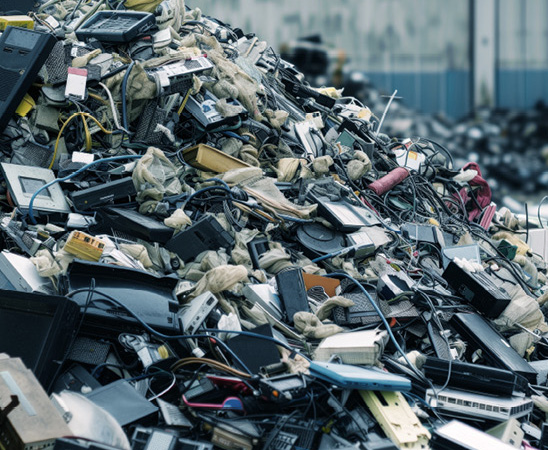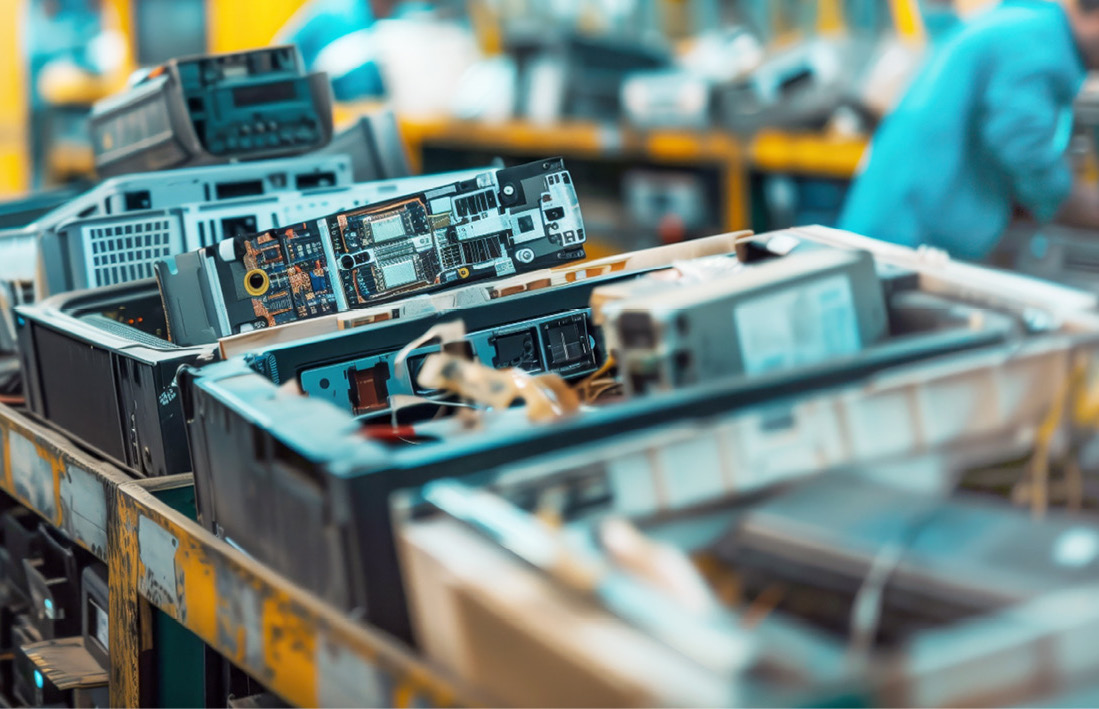In 2015, the United Nations General Assembly adopted a resolution that had the objective of transforming the world in terms of sustainable development. The assembly took numerous goals and targets for global action over the next 15 years. These goals covered a range of concerns, including sustainable production and consumption. In particular, clause 12.5 of the publication mentions the aim of reducing the generation of waste through prevention, recycling, and reuse.
According to the Global E-Waste Monitor Report, 5 million tons of e-waste is produced by small telecommunication and IT equipment, which includes laptops and mobile phones. Not only that, even acquiring raw materials, manufacturing, assembling, transporting, and distributing ICT goods releases harmful emissions into the environment. Leaving the usage and end-of-life stage, embodied emissions1 released per device, including a laptop, were 200 kg CO2e, desktops were 350 kg CO2e, and smartphones were 50 kg CO2e. (CO2e – Carbon dioxide equivalent). These staggering numbers prove that it is insufficient to properly dispose of e-waste. Rather, organizations must take initiatives to reduce the number of IT assets that end up as e-waste by repairing and reusing the devices.
The global volume of e-waste reached 62 million metric tons in 2022, with enterprises contributing a major share due to frequent technology updates. Many IT assets are discarded due to minor malfunctions or performance issues that could have been diagnosed, rectified, and repaired, preventing environmental harm. In fact, the ‘Right to Repair’ movement catalyzes this initiative. Repairing a device extends its lifespan and prevents it from becoming e-waste despite being functional. The owner can either retain the repaired IT assets or resell them; both ways, the devices will stay in the usage cycle and prevent environmental damage.

What are the Challenges in Repairing the IT Assets?
Over the years, IT assets have been getting slimmer and more compact. Manufacturers are saving on costs by manufacturing laptops, PCs, and mobile devices in this manner. Devoid of connectors and the requirement of soldering the components together, these IT assets get difficult and expensive to repair. When repairing or replacing a component due to a minor dysfunction becomes more expensive than buying a new IT asset, organizations are forced to discard a used device to buy a brand-new one.
Moreover, these slimmer devices with embedded drives and other components are tougher to recycle and dispose of responsibly, creating more e-waste. According to the Global E-Waste Monitor Report 2024, e-waste is projected to rise to 82 million tons in 2030. Businesses committed to reducing their environmental impact try to minimize their carbon footprint by prioritizing sustainable production and preventing e-waste generation. As the right-to-repair laws get more stringent and manufacturers agree to meet them mid-way, organizations can proactively choose to repair their malfunctioning devices and reuse them frequently. The use of hardware diagnosis software can contribute to this cause by ensuring faulty components are diagnosed and repaired efficiently.
What is the Need for Hardware Diagnostics Tool?
A hardware diagnostics tool is a software-based program that runs specific tests to check the functionality of various components of an IT asset, like a PC, Mac, laptop, and server. From CPU, RAM, storage, and battery to peripherals like mouse, webcam, and keyboard – everything is tested by the hardware diagnostics tool through a series of assisted and automated tests. A good tool also helps in grading the device in the A, B, and C categories to get an optimum resale value.
For ITADs governed by reuse and recycling standards such as the Sustainable Electronics Recycling International’s (SERI) R2 standard, repairing a malfunctioning IT asset is an essential requirement of the certification process. Appendix C – Test and Repair specifically requires the R2 facility to test the equipment and components according to their R2 Reuse Plan. The R2 Reuse Plan is supposed to be documented by the R2 facility. It should include extensive information on equipment tested for each function, testing methods, methods of documenting results, etc. Under the quality assurance plans for devices tested okay, data sanitization verification must be performed to ensure it is compliant with Appendix B – Data Sanitization. The functional equipment must be reused, and non-functional equipment should be managed for material recovery.
In order to demonstrate compliance with the requirements of R2 and other standards like e-Stewards and Waste Electric and Electronic Equipment (WEEE), ITADs need to present documented evidence to back their claims. A professional hardware diagnostics software produces a detailed report mentioning the status of each component tested. This document can serve as proof in front of the regulatory authorities.
Apart from ITADs, organizations that are committed to actively reducing their Green House Gases (GHG) emissions promote the reuse of IT assets within their organizations or donate them outside. Further, many marketplaces and IT asset manufacturers who sell online offer trade-in and buy-back programs for old IT assets. These companies generally aim to diagnose used devices for device functionality. Upon finding them suitable for reuse, they are either donated to less-privileged communities to bridge the digital divide or given to Non-Profit Organizations (NPOs) to meet the CSR goals.

How does IT Hardware Diagnosis Contribute to Sustainability?
Apart from minimizing the environmental impact, lowering the costs of purchasing new equipment, and supporting circular economy principles, hardware diagnosis contributes to sustainability by:
- Promoting Reuse and Reducing E-Waste: Most organizations go through their periodic upgrade or refresh cycle every year. Large data centers such as those operated by Google, Microsoft, or Amazon periodically diagnose server health and upgrade the equipment instead of replacing them entirely. Such initiatives significantly reduce e-waste and energy consumption spent on the production of new devices. Organizations worldwide are required to report their contribution to sustainability. Many EU and non-EU-based businesses subject to turnover, number of employees, and size are mandated to report on their share toward sustainability as per the requirements of the Corporate Sustainability Reporting Directive (EU-CSRD). Reusing devices and reducing carbon emissions release can positively reflect on the organization’s sustainability report.
- Saving Time & Resources Physically opening an IT asset to diagnose faults is time-consuming and requires technical expertise. Outsourcing these services increases costs due to expert fees, supervision for a secure chain of custody, and transportation expenses. A hardware diagnostics software instead requires basic familiarity with digital devices, is compatible with diverse IT assets, and does not require dismantling storage media; it saves time, cost, and resources—enhancing sustainability.
- Bridging the Digital Divide: Despite increased IT asset production, internet-enabled digital devices remain inaccessible to many. The digital divide spans socioeconomic status, gender, and geography. As per a 2021 survey conducted by the Pew Research Center, only 59% of US adults whose yearly household income is less than $30,000 own a laptop or a PC. The UN’s Sustainable Development Goals (SDGs) specify the significance of the spread of ICT and global connectivity in bridging the digital divide. Organizations can donate used devices after erasing business-critical information and using diagnostic tools to verify their functionality, aligning with CSR initiatives.
Contributing to Circular Economy: Digital device manufacturing requires the mining of raw materials that are often used as internal components. When an IT asset is not fit for reuse, the internal components are extracted & repurposed. The recovered metals from e-waste that were brought back into the circular economy were estimated to be worth US $28 billion. A hardware diagnostics tool can assess reuse potential and market value before an IT asset is discarded, ensuring maximum resource recovery.
Lessons Learnt
The increase in the recycling of e-waste has exceeded the generation of e-waste by a factor of 5 since 2010. The figure should be considered a warning and a reason to take sustainability more seriously. It is an opportunity for organizations to review their sustainability goals, recreate their IT asset use and disposal policies, and utilize hardware diagnostics tools to enable the reuse of usable devices.
A hardware diagnostics tool performs tests such as memory stress, disk storage, battery capacity, and audio functionality. Beyond internal component assessment, it also verifies wireless network connectivity. Once detected faults are repaired, the digital device can be reused—preventing waste and supporting sustainability.
1. https://www.sciencedirect.com/science/article/pii S1364032123002794?via%3Dihub
Namrata Sengupta is a dynamic business leader with over 27 years of experience in business strategy, management, and global partnerships across diverse sectors, including IT, telecom, and education. As the Senior Vice President at Stellar for more than 12 years, she leads the global expansion of Stellar's software products in data erasure, data recovery, and file repair. A recognized thought leader in data privacy and destruction solutions, Namrata speaks at prominent global events such as the IAITAM Conference, ITAD Summit, and ADISA Conference. She is passionate about promoting diversity and inclusion in the workplace, advocating for equality and empowerment within organizations. Her expertise encompasses business management, sales, marketing, and communication, driving revenue growth, enhancing profitability, and delivering results in challenging environments. As a member of the Forbes Technology Council, Namrata contributes articles on data destruction and emphasizes the critical importance of data security.